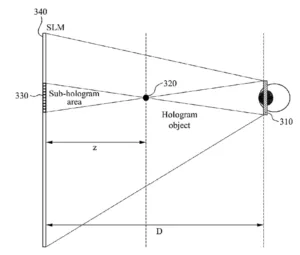Samsung Electronics Co., Ltd. is continuing to work on means of generating digital holograms and a device for holographic display. A recent public indication of the company’s activity in this area is manifested in a just published patent application number 14/328227. It is entitled “Sub-Hologram Generation Method and Apparatus for Holographic Display,” filed on July 10, 2014 and published as 2015-0146271 on May 28, 2015. The application is available on-line and can be found here.
The patent application discloses a method to generate the fringe pattern required for digital holograms by approximating optical signals by performing a mathematical operation. “In the digital hologram generation method, a 3D object may be considered an aggregate in that a point-hologram of each point included in the 3D object may be calculated and summed, thereby acquiring a hologram pattern of the 3D object”. This condition describes the first difficulty in creating the hologram: the complexity and number of calculations required to acquire the 3D object is directly related to the number of 3D points to be expressed. When the number of points required to express the 3D object goes up, the number of required calculations will also go up. The result is that the generation of a useful, real time hologram may become quite cumbersome.
There is a second challenge in production of digital holograms that relates to achieving the desired viewing angle for the hologram. A means often used to generate the desired interference pattern is to diffract the light off a Spatial Light Modulator (SLM). In this case, the diffraction angle of the light is inversely proportional to a size of the pixels in the SLM. The challenge derives from the fact that there is a limit to how small it is possible to make SLM pixels. It follows, therefore, that expanding the hologram viewing angle can become difficult.
Samsung’s disclosed approach to dealing with these issues generally relates to the creation of sub-holograms and production of an associated holographic display apparatus based on the use of these sub-holograms. More specifically, Samsung’s approach relates to a method of determining a hologram area to reduce the complexity of the hologram display.
According to Samsung, when the hologram generation apparatus generates a hologram in a sub-hologram area corresponding to an eye position of a viewer using a viewpoint tracing process, the complexity and number of calculations required to generate the fringe pattern goes down and, thus, it is possible to produce a wide-view hologram display.
If this approach fully lives up to its apparent potential, it may represent an important step in the implementation of holographic displays in consumer electronic devices. Note, however, that in as much as the technology is still under development, the timing for any Samsung products utilizing the technology is currently unknown. – Arthur Berman

